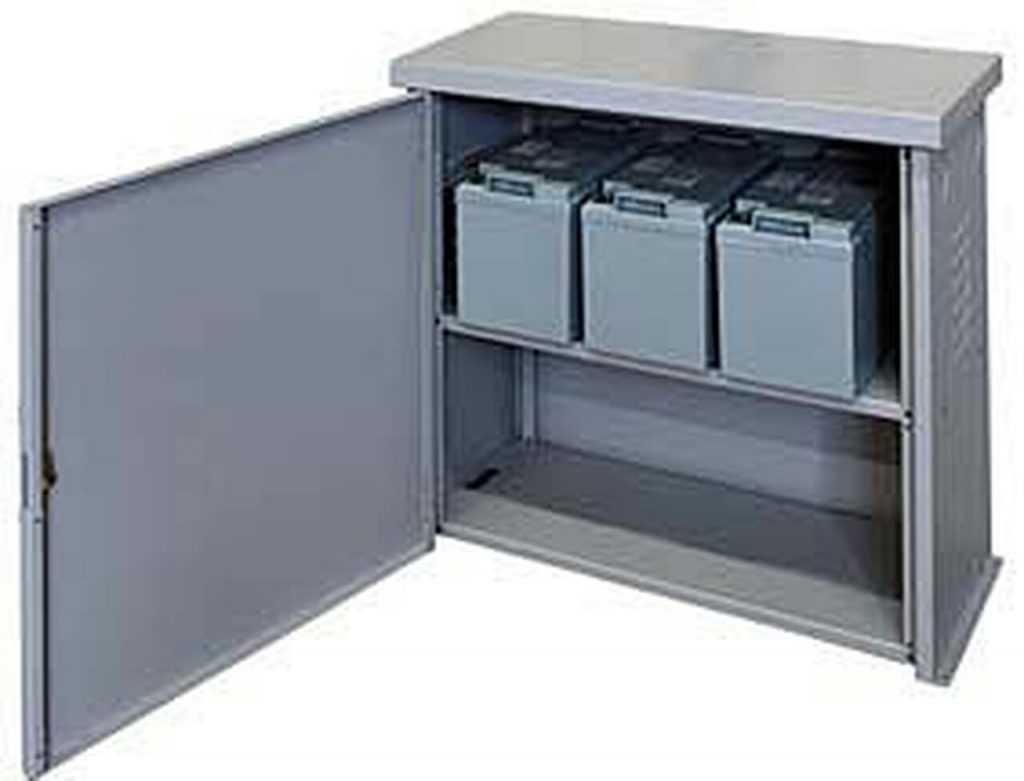Wondering how to store solar batteries correctly? You’ve come to the right place!
It’s no secret that renewable energy storage is becoming more popular (and also necessary). With the cost of solar energy declining, more people are looking for ways to store their solar energy to use it later on.
Solar batteries are a great way to store solar energy. With a solar battery system, you can use solar energy even at night, increasing your energy autonomy and providing a good solution for power outages and energy situations.
However, depending on where you live, and the season you’re in, the amount of solar radiation (or sun hours) may not be enough to charge your solar batteries all year round efficiently, so you might have to store them for a certain period.
During such times, it’s essential to store solar batteries correctly to ensure that they stay in good shape — maintaining their capacity, performance, and lifespan. This way, they will be ready for use when you need them again.
In this article, we’ll walk you through five simple steps to store solar batteries correctly so you can get the most out of them! By following these simple storage tips, you can efficiently prolong the life of your solar batteries.
Furthermore, we’ll answer a few common questions about storing solar batteries.
Table of Contents
How To Store Your Solar Batteries Correctly
Correctly storing your solar batteries is crucial to maintaining their lifespan and efficiency. Here is a 5 step guide on how to store your solar batteries properly:
1. Check The Manufacturer’s Instructions
First and foremost, you want to make sure you store your solar batteries according to the manufacturer’s recommendations. This way, you’ll keep them safe and in a way that won’t void the warranty.
The best way of knowing how to store your solar batteries properly is by reading the user manual. And if you have any further questions, you can try to contact the manufacturer.
2. Avoid Extreme Temperatures And Humidity
Both hot and cold temperatures can damage your solar batteries, so it’s essential to store them in a relatively cool (between 59ºF to 68ºF (or 15ºC to 20ºC)) area that is not subject to extreme temperature changes.
Moreover, since humidity is one of the biggest enemies of batteries, keep them in a dry environment, away from any direct sunlight or heat source.
A cool, well-ventilated, dry area is ideal (don’t store them in living areas, though). If possible, keep them in a vented enclosure or battery box to avoid any moisture from accumulating.

Source: mrsolar.com
3. Monitor Their State Of Charge (SoC)
Storing fully charged batteries may accelerate degradation over time, resulting in capacity loss and shorter battery life. Conversely, if you store them completely discharged, they may not hold a charge as well when you use them again. Instead, try to store them at a moderate SoC.
For instance, if you won’t be using your solar batteries for an extended period (during the winter, for example), it’s best to store them in a relatively low state of charge rather than at 100%. However, you can store fully charged lead-acid batteries since they shouldn’t be partially charged).
That’s because the self-discharge rate is directly proportional to the SoC, so the higher the SoC, the higher the self-discharge rate.
Store Solar Batteries At A Safe SoC Range
Manufacturers usually recommend storing LiFePO4 batteries at around 50% SoC. This type of solar battery has a low self-discharge rate, so you don’t need to recharge them often to maintain an acceptable SoC.
On the other hand, AGM and Gel batteries have a higher self-discharge rate, so you should give them a boost charge every 2 to 3 months or when they reach approximately 75% state of charge.
Recharge Your Solar Batteries Regularly
Even if you’re not planning to use them anytime soon, it’s imperative to avoid storing solar batteries (especially lead-acid batteries) at a low charge.
Therefore, if you need to store solar batteries for an extended period, make sure you recharge them from time to time to keep them in good condition. This will help prevent the cells from degrading and losing their capacity.
Most manufacturers recommend recharging lead-acid batteries every 2 to 3 months and lithium batteries every 6 months.
4. Keep Your Solar Batteries Clean

Source: the-diy-life.com
Dirt and dust can cause the batteries to corrode and degrade over time. To avoid any damage related to corrosion, regularly wipe down the battery with a damp cloth to remove any build-up.
5. Disconnect The Batteries From Other Devices
Parasitic loads are devices that continue to draw current from an energy source (in this case, the battery) even when turned off/on standby.
For this reason, parasitic loads can be real silent battery killers. They can completely drain the battery without you noticing.
To avoid this issue, before storing the battery, disconnect it from any device, including inverters, charge controllers, etc.
Can You Store A Solar Battery On Its Side?
In general, AGM, Gel, and LiFePO4 batteries can be installed and stored on their side without suffering any damage.
Sealed lead-acid batteries such as AGM and Gel are commonly known as “maintenance-free” batteries. Why? Because they require almost no maintenance compared to flooded lead-acid batteries, which need watering, venting, etc.
A significant difference between these batteries is that, as the name suggests, a flooded lead-acid battery is actually “flooded” with electrolytes. This way, if you lay it on its side, the electrolyte will move inside the battery, leaking and exposing the lead plates.
Conversely, in AGM and Gel batteries, the electrolyte is soaked in the separator (thus contained by the separator). It doesn’t move around like a liquid inside the battery. For this reason, you can store and use AGM and Gel batteries on their side.
Similarly, you can also mount and store a LiFePO4 battery on its side — this type of battery is not liquid-filled, so it won’t leak.
However, if you can avoid it, you should probably do so.
Even though they won’t suffer any immediate damage, these solar batteries are designed to be used/stored in a particular orientation (upright). Storing them on their side can potentially damage their terminals, which isn’t ideal.
If you decide to go through with it and store your solar battery on its side, make sure to secure the battery in place so that it cannot fall over or roll around.
How Long Can You Keep Solar Batteries In Storage?
The amount of time you can safely keep a solar battery in storage depends on the battery’s chemistry/type.
For instance, you can store a LiFePO4 for longer than AGM or Gel without it suffering significant damage, such as decreased lifespan or capacity loss.
Why? Because LiFePO4 batteries have a low self-discharge rate, and therefore can hold a charge for a longer period. This ability prevents the battery from reaching a low (and unsafe) state of charge, which can be detrimental to the battery’s health.
Battery storage temperature is another factor that impacts the amount of time you can safely store solar batteries (also called “shelf life”). You can store solar batteries for a shorter period at high or low temperatures. However, you can store them for much longer at room temperature.
You can generally store lead-acid batteries (Flooded, AGM, and Gel) for up to 2 years if you maintain and store them properly (recharge every 3 months, etc.).
In contrast, the shelf life of LiFePO4 batteries is between 5 and 8 years. Of course, that only holds true if you correctly store and maintain the battery during these years (keep clean, dry, at room temperature, charge it to a safe SoC every 6 months, etc.).
Can You Store Solar Batteries Outside?
Can you store solar batteries outside? Yes. Should you store batteries outside? Not exactly.
If by “outside,” you mean in a shed, then it should be ok for a few months (if the environment is cool, dry, and well ventilated). But if you mean outside without any shelter, then definitely not.
Solar batteries are designed to withstand a wide range of temperatures. However, they may not fare as well if you expose them to constant sun, extreme heat, rain, cold temperatures, humidity, snow, etc.
And while most modern solar batteries are water-resistant, it’s still a good idea to keep them out of direct sunlight or rain as it will most likely damage them over time.
Direct sunlight can damage the battery case and increase the battery’s internal temperature. This can seriously damage the cells, resulting in dangerously swollen batteries.

Source: nocheski.com
In summary, if you want to correctly store your solar batteries so they can last a long time and perform well when you need them, don’t store them outside.
Instead, store your solar batteries in a dry, well-ventilated, temperature-controlled environment, away from direct sunlight, water, heat sources, or freezing temperatures.
How Can You Keep Stored Solar Batteries Warm?
Depending on your climate, you may need to take extra steps to keep your stored solar batteries warm.
For example, if the temperature dips below freezing, the water in lead-acid batteries can expand and damage the cells’ structure. This can lead to decreased performance and a shorter lifespan.
To avoid issues associated with cold temperatures, you should adopt a few preventive measures:
Provide Your Solar Batteries Shelter And Insulation
The best way to keep solar batteries warm is by simply providing shelter and proper insulation.
You can safely install and store LiFePO4 batteries inside your house where the temperature is controlled. This way, you don’t have to get creative to provide these two basic needs (shelter and insulation).
However, it isn’t as safe to store lead-acid batteries inside your house, so this battery usually requires more attention during winter.
Alternatively, you can store this solar battery in an enclosure or battery box with holes to allow ventilation (and avoid moisture from accumulating).
Placing this battery box in an insulated area (shed, garage, basement, etc.) helps keep the battery warm. You can even use an insulated battery box/enclosure for extra warmth.
As a last resort, if temperatures drop significantly, you can use a small heating vent to maintain a safe temperature in the area where you’re storing your batteries. Just make sure the room is ventilated and the heater is placed at a safe distance from the batteries.
By following these simple steps, you can ensure that your stored solar batteries remain charged and ready to use when you need them.
Final Thoughts
And there you have it — five easy steps on storing solar batteries correctly.
By following these simple steps, you’ll ensure that your solar batteries last as long as possible in storage while still performing well when you need to use them again.
Furthermore, you know if you can store a solar battery on its side, how long they can last in storage, if you can store them outside and how to keep them warm during winter.
Have we missed anything? Do you have any questions about how to store solar batteries? Let us know in the comments below — we’d be happy to help!

